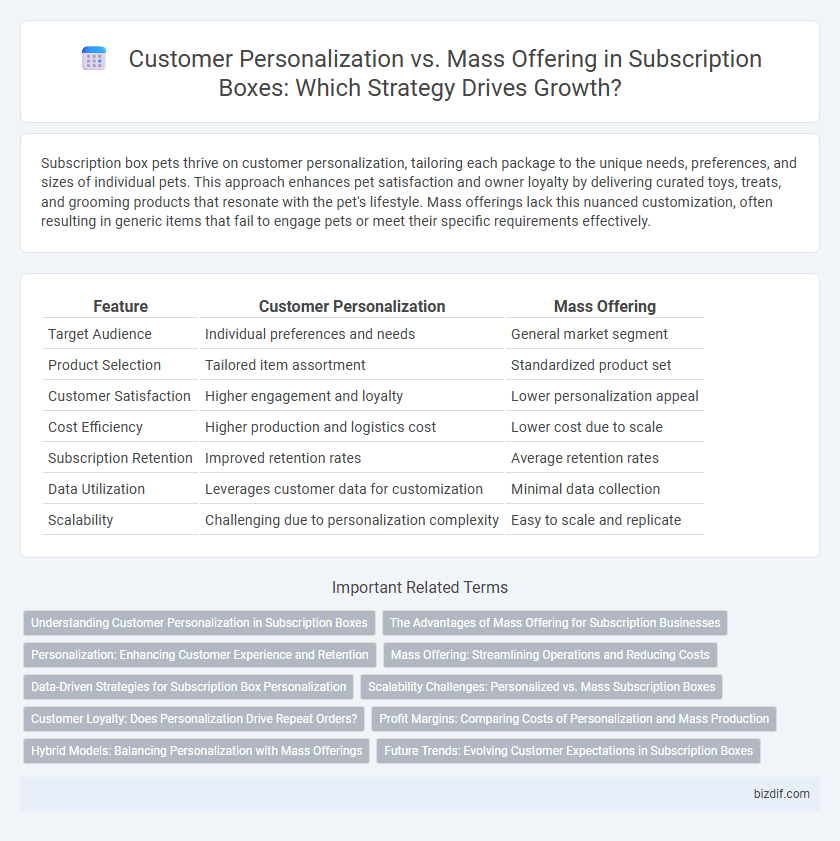Subscription box pets thrive on customer personalization, tailoring each package to the unique needs, preferences, and sizes of individual pets. This approach enhances pet satisfaction and owner loyalty by delivering curated toys, treats, and grooming products that resonate with the pet's lifestyle. Mass offerings lack this nuanced customization, often resulting in generic items that fail to engage pets or meet their specific requirements effectively.
Table of Comparison
| Feature | Customer Personalization | Mass Offering |
|---|---|---|
| Target Audience | Individual preferences and needs | General market segment |
| Product Selection | Tailored item assortment | Standardized product set |
| Customer Satisfaction | Higher engagement and loyalty | Lower personalization appeal |
| Cost Efficiency | Higher production and logistics cost | Lower cost due to scale |
| Subscription Retention | Improved retention rates | Average retention rates |
| Data Utilization | Leverages customer data for customization | Minimal data collection |
| Scalability | Challenging due to personalization complexity | Easy to scale and replicate |
Understanding Customer Personalization in Subscription Boxes
Understanding customer personalization in subscription boxes enhances user engagement by tailoring products to individual preferences, increasing satisfaction and retention rates. Data-driven insights and customer feedback enable brands to curate unique experiences, setting them apart from mass offerings that lack customization. Personalized subscription boxes leverage algorithms and consumer behavior analysis to deliver relevant items, fostering loyalty and higher lifetime value.
The Advantages of Mass Offering for Subscription Businesses
Mass offering in subscription businesses enables streamlined operations and reduced costs by standardizing products for a broad customer base. By focusing on popular, high-demand items, companies can optimize inventory management and ensure faster delivery times. This approach enhances scalability, allowing businesses to grow quickly without the complexities of individualized customization.
Personalization: Enhancing Customer Experience and Retention
Customer personalization in subscription boxes tailors product selections to individual preferences, boosting engagement and satisfaction. Data-driven algorithms analyze user behavior and feedback to deliver curated experiences that resonate with subscribers, increasing loyalty. Personalized offerings reduce churn rates by making customers feel valued and understood, fostering long-term retention.
Mass Offering: Streamlining Operations and Reducing Costs
Mass offering subscription boxes streamline operations by standardizing product selection and packaging, enabling bulk purchasing that lowers production costs. This approach simplifies inventory management and accelerates fulfillment processes, improving overall efficiency. By reducing complexity, companies can offer competitive pricing while maintaining consistent quality across a broad customer base.
Data-Driven Strategies for Subscription Box Personalization
Data-driven strategies empower subscription box services to tailor offerings based on individual customer preferences, purchase history, and behavior analytics rather than mass generic products. Leveraging machine learning algorithms and customer segmentation enhances personalization accuracy, increasing retention rates and customer satisfaction. Real-time data integration from user feedback and consumption patterns ensures dynamic adjustments, optimizing the relevance of each subscription box delivery.
Scalability Challenges: Personalized vs. Mass Subscription Boxes
Customer personalization in subscription boxes delivers tailored experiences based on individual preferences, driving higher engagement and retention but requires complex data management and inventory customization. Mass subscription boxes benefit from streamlined operations and predictable scalability but often struggle to meet diverse customer expectations, risking lower satisfaction rates. Balancing personalization with scalability involves sophisticated algorithms and flexible supply chains to efficiently scale without compromising the unique appeal of customized offerings.
Customer Loyalty: Does Personalization Drive Repeat Orders?
Personalization in subscription boxes increases customer loyalty by tailoring product selections to individual preferences, leading to higher repeat order rates. Data shows that customers who receive personalized boxes are 80% more likely to reorder compared to those receiving mass offerings. This targeted approach fosters deeper engagement and long-term brand affinity.
Profit Margins: Comparing Costs of Personalization and Mass Production
Customer personalization in subscription boxes often increases profit margins by justifying higher price points through tailored experiences, despite elevated production costs. Mass offering benefits from economies of scale, reducing per-unit costs but typically commands lower prices due to generic appeal. Balancing customization expenses with consumer willingness to pay is crucial for maximizing profitability in subscription services.
Hybrid Models: Balancing Personalization with Mass Offerings
Hybrid subscription box models combine the efficiency of mass offerings with the appeal of customer personalization by using algorithm-driven selection alongside curated popular items. These models leverage data analytics and customer preferences to tailor a core set of products while maintaining standardized inventory, reducing costs and delivery complexity. Balancing scalability and customization enables enhanced customer satisfaction and retention without sacrificing operational efficiency.
Future Trends: Evolving Customer Expectations in Subscription Boxes
Subscription box services increasingly prioritize customer personalization by leveraging AI-driven algorithms and data analytics to curate tailored product selections that enhance user satisfaction and retention. Mass offerings, once dominant, are losing ground as consumers demand unique, relevant experiences that reflect their individual preferences and lifestyles. Future trends indicate a continued shift toward hyper-customization, integrating real-time feedback and predictive modeling to anticipate evolving customer needs in subscription boxes.
Customer personalization vs mass offering Infographic

 bizdif.com
bizdif.com